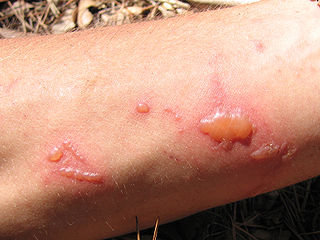Related Research Articles

In immunology, an antigen (Ag) is a molecule or molecular structure, such as may be present on the outside of a pathogen, that can be bound by an antigen-specific antibody or B-cell antigen receptor. The presence of antigens in the body normally triggers an immune response. The Ag abbreviation stands for an antibody generator.
In physics, a fluid is a substance that continually deforms (flows) under an applied shear stress, or external force. Fluids are a phase of matter and include liquids, gases and plasmas. They are substances with zero shear modulus, or, in simpler terms, substances which cannot resist any shear force applied to them.
A non-Newtonian fluid is a fluid that does not follow Newton's law of viscosity, i.e., constant viscosity independent of stress. In non-Newtonian fluids, viscosity can change when under force to either more liquid or more solid. Ketchup, for example, becomes runnier when shaken and is thus a non-Newtonian fluid. Many salt solutions and molten polymers are non-Newtonian fluids, as are many commonly found substances such as custard, honey, toothpaste, starch suspensions, corn starch, paint, blood, melted butter, and shampoo.

A lymphocyte is a type of white blood cell in the immune system of jawed vertebrates. Lymphocytes include natural killer cells, T cells, and B cells. They are the main type of cell found in lymph, which prompted the name "lymphocyte".
Cytotoxicity is the quality of being toxic to cells. Examples of toxic agents are an immune cell or some types of venom, e.g. from the puff adder or brown recluse spider.
Cyclohexane is a cycloalkane with the molecular formula C6H12. Cyclohexane is non-polar. Cyclohexane is a colourless, flammable liquid with a distinctive detergent-like odor, reminiscent of cleaning products (in which it is sometimes used). Cyclohexane is mainly used for the industrial production of adipic acid and caprolactam, which are precursors to nylon.
An elastic modulus is a quantity that measures an object or substance's resistance to being deformed elastically when a stress is applied to it. The elastic modulus of an object is defined as the slope of its stress–strain curve in the elastic deformation region: A stiffer material will have a higher elastic modulus. An elastic modulus has the form:

A chemical burn occurs when living tissue is exposed to a corrosive substance or a cytotoxic agent. Chemical burns follow standard burn classification and may cause extensive tissue damage. The main types of irritant and/or corrosive products are: acids, bases, oxidizers / reducing agents, solvents, and alkylants. Additionally, chemical burns can be caused by some types of cytotoxic chemical weapons, e.g., vesicants such as mustard gas and Lewisite, or urticants such as phosgene oxime.

Phototoxicity, also called photoirritation, is a chemically induced skin irritation, requiring light, that does not involve the immune system. It is a type of photosensitivity.

Teniposide is a chemotherapeutic medication used in the treatment of childhood acute lymphocytic leukemia (ALL), Hodgkin's lymphoma, certain brain tumours, and other types of cancer. It is in a class of drugs known as podophyllotoxin derivatives and slows the growth of cancer cells in the body.

Metenolone enanthate, or methenolone enanthate, sold under the brand names Primobolan Depot and Nibal Injection, is an androgen and anabolic steroid (AAS) medication which is used mainly in the treatment of anemia due to bone marrow failure. It is given by injection into muscle. Although it was widely used in the past, the drug has mostly been discontinued and hence is now mostly only available on the black market. A related drug, metenolone acetate, is taken by mouth.
The Thermoactinomycetaceae are a family of Gram-positive endospore-forming bacteria.
In theology, a deus otiosus or "idle god" is a creator god who largely retires from the world and is no longer involved in its daily operation, a central tenet of Deism.
Tegafur/gimeracil/oteracil, sold under the brand names Teysuno and TS-1, is a fixed-dose combination medication used for the treatment of advanced gastric cancer when used in combination with cisplatin, and also for the treatment of head and neck cancer, colorectal cancer, non–small-cell lung, breast, pancreatic, and biliary tract cancers.
Streptomyces atratus is a bacterium species from the genus of Streptomyces which has been isolated from soil in Shimoneda in Japan. Streptomyces atratus produces atramycin A, hydrazidomycins A, hydrazidomycins B, hydrazidomycins C, rufomycins A and rufomycins B.
Erythrobacter is a Gram-negative and rod-shaped bacteria genus from the family of Sphingomonadaceae.

Boldenone undecylenate, or boldenone undecenoate, sold under the brand names Equipoise and Parenabol among others, is an androgen and anabolic steroid (AAS) medication which is used in veterinary medicine, mainly in horses. It was formerly used in humans as well. It is given by injection into muscle.
Mechercharimyces is a Gram-positive and chemoorganotroph bacterial genus from the family of Thermoactinomycetaceae.
Mechercharimyces mesophilus is a Gram-positive bacterium from the genus of Mechercharimyces which has been isolated from sediments from the Jellyfish Lake in Palau.
Gymnascella dankaliensis is a moderate to slow growing fungus commonly found in the soil of warmer climates. It is characterized by round yellow, orange or red-brown ascospores encircled by undifferentiated filaments. They have been found in ear, nail and skin infections. Their metabolites have been isolated and shown to have cytotoxic and anti-tumor properties.
References
- 1 2 Parte, A.C. "Mechercharimyces". LPSN .
- ↑ "Mechercharimyces asporophorigenens Taxon Passport - StrainInfo". www.straininfo.net.
- 1 2 "Details: DSM-44955". www.dsmz.de.
- ↑ "Mechercharimyces asporophorigenens". www.uniprot.org.
- ↑ Matsuo, Yoshihide; Kanoh, Kaneo; Yamori, Takao; Kasai, Hiroaki; Katsuta, Atsuko; Adachi, Kyoko; Shin-ya, Kazuo; Shizuri, Yoshikazu (April 2007). "Urukthapelstatin A, a Novel Cytotoxic Substance from Marine-derived Mechercharimyces asporophorigenens YM11-542". The Journal of Antibiotics. 60 (4): 251–255. doi: 10.1038/ja.2007.30 . PMID 17456975.
- ↑ Ali, Pourhashemi; Gennady E., Zaikov; A. K., Haghi (2015). Chemical and Biochemical Engineering: New Materials and Developed Components. CRC Press. ISBN 978-1-482-25243-9.